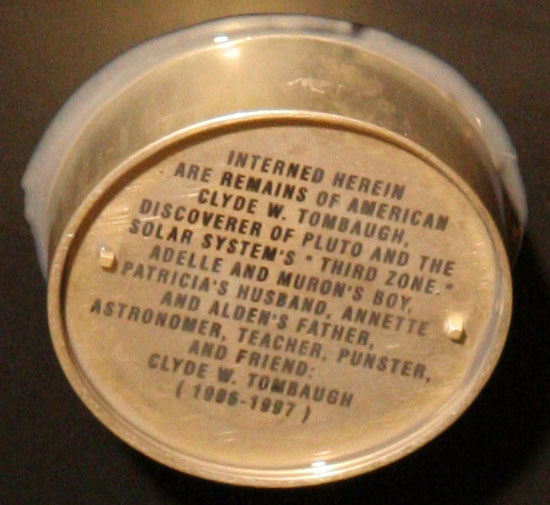On July 14, 2015, NASA’s New Horizons spacecraft flew past Pluto, carrying a small amount of the ashes of American astronomer Clyde W. Tombaugh, along with the dreams of all who, like this Kansas farm boy, gazed toward the heavens in the name of exploration and discovery. New Horizons, the first mission to Pluto, provided the closest look ever at the ninth planet while completing the initial reconnaissance of the solar system.
When Tombaugh discovered Pluto in 1930, he opened the gateway to an unknown region of ancient, icy objects unlike any worlds in our solar system — and touched off a revolution in our understanding of Earth’s ever-expanding planetary neighborhood.
Like so many of the people honored on Celestis memorial spaceflights, Clyde Tombaugh was fascinated by the stars. In this video Tombaugh’s son and daughter reflect on their father’s discovery of, and memorial spaceflight to Pluto. As his daughter puts it, “He would have been astounded.”
Tombaugh was 24 years old and working at Lowell Observatory in Flagstaff, Arizona, when he made his landmark find in 1930 — capping a search for a “trans-Neptunian” planet in which he photographed two-thirds of the sky and spent thousands of hours examining millions of star images. Thought at first to be a planetary oddity because of its small size and strange, elliptical orbit, Pluto eventually heralded the discovery of the Kuiper Belt and the growing realization that small, icy dwarf planets are common in our solar system. The Kuiper Belt is an expansive “third zone” on the solar system’s frontier that contains thousands of worlds different from both the rocky inner planets and the outer gas giants.

Tombaugh died on January 17, 1997, a few weeks shy of his 91st birthday, almost exactly nine years before New Horizons launched from Cape Canaveral Air Force Station, Florida, on January 19, 2006.
In memory of the first American to discover a planet in our solar system, the piano-sized New Horizons spacecraft carries a small aluminum canister containing some of Tombaugh’s cremated remains, donated by his family. New Horizons will eventually escape our solar system altogether and enter interstellar space. As such, Tombaugh’s remains have become the first to be launched to the stars.
The memorial canister, about two inches wide and half-an-inch tall, is attached to the inside, upper deck of the spacecraft. Just as Celestis includes “flight messages” for each of its memorial spaceflight participants on board Celestis spacecraft, the New Horizons canister includes a memorial message about Clyde Tombaugh:
Interned herein are remains of American Clyde W. Tombaugh, discoverer of Pluto and the solar system’s “third zone.” Adelle and Muron’s boy, Patricia’s husband, Annette and Alden’s father, astronomer, teacher, punster, and friend: Clyde W. Tombaugh (1906-1997).

“It’s a wonderful tribute,” said Clyde Tombaugh’s late wife, Patricia “Patsy” Tombaugh, at the time of the New Horizons launch. “I certainly thought of my husband when the rocket launched, because a part of him was on there. It seemed so appropriate, too, because it was so close to his 100th birthday.”
Columnist Charles Krauthammer perhaps put it best when he wrote:
One final touch. Every ounce of superfluous weight has been stripped from New Horizons to give it more speed and pack more instruments. Yet there was one concession to poetry. New Horizons is carrying some of Clyde Tombaugh’s ashes. After all, he found the dot. Not only will he fly by his netherworldly discovery, notes Carter Emmart of the American Museum of Natural History, he will become the first human being to have his remains carried beyond the solar system.
For the wretched race of beings we surely are, we do, on occasion, manage to soar.
New Horizons is the first mission in NASA’s New Frontiers Program. Dr. Alan Stern from the Southwest Research Institute in Boulder, Colorado leads the mission and science team as principal investigator. The Johns Hopkins University Applied Physics Laboratory (APL) in Laurel, Maryland, manages the mission for NASA’s Science Mission Directorate and designed, built and operates the New Horizons spacecraft.
Celestis Voyager Service missions fly a symbolic portion of ashes into deep space. Click here for more information.
